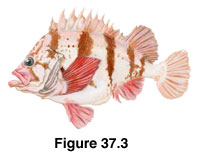 Description
Description
Sebastes nigrocinctus
(Tiger Rockfish)
(Other common names: Banded Rockfish, Black-Banded Rockfish)
Figure 37.3
 Description
DescriptionLength: 61 cm.
Mouth: large, terminal; upper jaw extends to mid-orbit; lower jaw projects past upper; snouth is blunt; teeth at tip lower jaw absent; symphyseal knob not always present.
Body: head spines well developed, sometimes they are divided into points; supraocular spines absent; preopercular spines coarse; opercular spines long and sharp; cleithral and supracleithral sharp and strong; caudal fin rounded; intraorbitat space concave.
Color: shades of gray, pink, to red with five black or red vertical bars across the body; two black or red bars radiate posteriorly from eye.
Depth: 10 to 275 m.
Habitat: rocky reefs with caves and crevices; juveniles pelagic and as they become adults they become demersal; solitary; highly territorial.
Season: ovoviparious; larvae in spring and summer juveniles drift with floating debris.
Diet: crustaceans (e.g., euphasiids, shrimps, crabs); forage fish (e.g.herring, sand lance).
Predators: not determined.
Distribution: central California to Alaska.
 Scale Description
Scale DescriptionRelative Scale Size: small to moderate.
Position of Scales on Body: in diagonal rows below lateral line canal 44-53 (Hart, 1973).
Overall Shape: the scales are generally square to rectangular with a somewhat longer lateral field with a moderately short posterior field.
Focus and Circuli: the focus abuts the edge of the posterior field, along the edge of ctenii growth, and is approximately one-fourth of the total scale length from the outside edge of the posterior margin. The circuli are continuous between the lateral and anterior fields (except broken by radii).
Radii: numbers are variable and not diagnostic. Radii present only in the anterior field. The outer edge of the anterior field edge is straight to convex and is slightly to moderately scalloped.